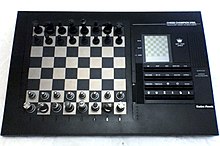
Back شطرنج الحاسوب Arabic Računarski šah BS Escacs per ordinador Catalan شەتڕەنجی کۆمپیوتەر CKB Computerskak Danish Computerschach German Ajedrez por computadora Spanish Tietokoneshakki Finnish Programme d'échecs French תוכנת שחמט HE

| This article is part of the series on |
| Chess programming |
|---|
 |
Computer chess includes both hardware (dedicated computers) and software capable of playing chess. Computer chess provides opportunities for players to practice even in the absence of human opponents, and also provides opportunities for analysis, entertainment and training. Computer chess applications that play at the level of a chess grandmaster or higher are available on hardware from supercomputers to smart phones. Standalone chess-playing machines are also available. Stockfish, Leela Chess Zero, GNU Chess, Fruit, and other free open source applications are available for various platforms.
Computer chess applications, whether implemented in hardware or software, utilize different strategies than humans to choose their moves: they use heuristic methods to build, search and evaluate trees representing sequences of moves from the current position and attempt to execute the best such sequence during play. Such trees are typically quite large, thousands to millions of nodes. The computational speed of modern computers, capable of processing tens of thousands to hundreds of thousands of nodes or more per second, along with extension and reduction heuristics that narrow the tree to mostly relevant nodes, make such an approach effective.
The first chess machines capable of playing chess or reduced chess-like games were software programs running on digital computers early in the vacuum-tube computer age (1950s). The early programs played so poorly that even a beginner could defeat them. Within 40 years, in 1997, chess engines running on super-computers or specialized hardware were capable of defeating even the best human players. By 2006, programs running on desktop PCs had attained the same capability. In 2006, Monty Newborn, Professor of Computer Science at McGill University, declared: "the science has been done". Nevertheless, solving chess is not currently possible for modern computers due to the game's extremely large number of possible variations.[1]
Computer chess was once considered the "Drosophila of AI", the edge of knowledge engineering. The field is now considered a scientifically completed paradigm, and playing chess is a mundane computing activity.[2]
- ^ Sreedhar, Suhas (2 July 2007). "Checkers, Solved!". IEEE Spectrum. Institute of Electrical and Electronics Engineers.
- ^ Ensmenger, N. (2012). "Is chess the drosophila of artificial intelligence? A social history of an algorithm". Social Studies of Science. 42 (1): 5–30. doi:10.1177/0306312711424596. PMID 22530382. S2CID 968033.
© MMXXIII Rich X Search. We shall prevail. All rights reserved. Rich X Search